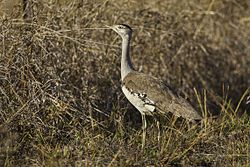Australian Bustard
| Australian bustard | |
|---|---|
 |
|
| Scientific classification | |
| Kingdom: | Animalia |
| Phylum: | Chordata |
| Class: | Aves |
| Order: | Otidiformes |
| Family: | Otididae |
| Genus: | Ardeotis |
| Species: | A. australia |
| Binomial name | |
|
Ardeotis australis (Gray, 1829) |
|
The Australian bustard (Ardeotis australis) is a large ground bird of grassland, woodland and open agricultural country across northern Australia and southern New Guinea. It is also commonly referred to as the plains turkey, and in Central Australia as bush turkey, particularly by Aboriginal people, though this name may also be used for the Australian brushturkey as well as the orange-footed scrubfowl.
The male is up to 1.2 m (47 in) tall with a 2.3 m (7.5 ft) wingspan. The average weight for males is 6.3 kg (14 lb), with a range of 4.3 to 12.76 kg (9.5 to 28.1 lb). The female is quite a bit smaller at 80 cm (31 in) tall, with a 1.8 m (5.9 ft) wingspan and an average body mass of 3.2 kg (7.1 lb) in a range of 2.4 to 6.35 kg (5.3 to 14.0 lb) but is similarly coloured.
The largest male recorded was 14.5 kg (32 lb). Although it is the largest extant flying land bird in Australia, this long-legged bird is the smallest species in the Ardeotis genus. The back, wings and tail are dull brown, mottled black and white markings on the wing coverts. The neck and head appear dull white and the crown black. Legs are yellow to cream coloured.
When disturbed, Australian bustards often adopt a cryptic pose with neck erect and bill pointed skywards. They may stalk gradually away or run if alarmed, taking flight as a last resort. Populations are highly nomadic following rain and feed, which includes seeds, fruit, centipedes, insects, molluscs, lizards, young birds and small rodents.
This bird remains relatively common and widespread across most of northern Australia (see Atlas), but its range appears to have contracted in the south-east of the continent during the last century, perhaps due to hunting (now illegal except for indigenous Australians), feral predators such as pigs and foxes and habitat destruction. Its nomadic habits make it difficult to assess. In 2012 IUCN downlisted the species to Least Concern.
The Australian bustard is not listed as threatened on the Environment Protection and Biodiversity Conservation Act 1999.
...
Wikipedia

